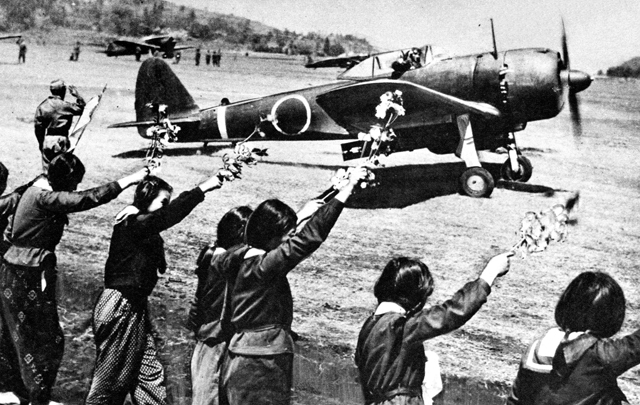On 21 October 1944 the first official Kamikaze strike took place, with the HMAS Australia hit and damaged by a Kamikaze attack. These suicide attacks were the scourge of the US fleet at Iwo Jima and Okinawa, with the Japanese armed forces building upon their initial success with weapons specially developed for Kamikaze attacks.
The extract below comes from New Vanguard 180: Kamikaze and looks at the Origins of the Kamikaze.
Chiran High School girls waving farewell with cherry blossom branches to a departing Kamikaze pilot
Source: Wikipedia
Origins of the Kamikaze - Tokko
Extract from New Vanguard 180: Kamikaze by Steven Zaloga
By the spring of 1944, the Imperial Japanese armed forces were on a precipitous slide to defeat. Any technological and tactical superiority enjoyed by the Imperial Japanese Navy (IJN) and Army (IJA) in 1941 had been eroded away by more than two years of war. This weakening was especially evident in the balance of air and naval power. In the hope of regaining a measure of tactical parity, a number of junior IJN and IJA officers in 1943 proposed a variety of suicide weapons, including crash boats, human torpedoes, and human-guided rocket bombs. There was widespread resistance to such extreme measures and concern that they would be unacceptable to the Emperor. Prior to the start of the official kamikaze campaign in the autumn of 1944, however, there had been occasional instances of Japanese aircraft crashing into US ships, dubbed jibaku attacks by Japanese pilots, but they were neither ordered nor organized by higher authorities.
The US amphibious landings in the Marianas, starting on June 15, 1944, penetrated Japan’s inner defensive line and put US Army Air Force (USAAF) B-29 bombers within range of Japanese homeland. The IJN activated its A-Go plan, dispatching most of its surviving carrier force towards the Philippine Sea in hopes of a decisive naval battle that would reverse the course of the war in the Pacific. Instead, the IJN carrier aviation force was annihilated in the “Marianas Turkey Shoot” by the US Navy on June 19, 1944. The battle of the Philippine Sea clearly demonstrated that the IJN had lost the edge it previously had over US carrier aviation and the balance of air power had shifted irredeemably in favor of the Americans.
In mid 1944, secret discussions were held among senior Japanese commanders about using organized suicide attacks as a means to restore a Japanese advantage. Following the battle of the Philippine Sea, Rear Adm Obayashi, commander of the 3rd Carrier Division, volunteered to form suicide units. Due to the Emperor’s ambivalent attitude towards this extreme tactic, the euphemism of “Tokko” (Tokubetsu kogeki: special attack) was used by the military for these tactics. In September 1944, the commanders of the IJA 4th Air Army and the IJN’s 1st Air Fleet conducted a set of tests to examine bomber accuracy against ships in Manila harbor. The experiments concluded that only one in four well-trained crews would hit the target on average, while the expectation was that even a modestly trained suicide pilot would hit his target every time. With the start of US amphibious landings on Leyte in October 1944, the focus of the new Tokko tactics centered on the Philippines.
To read more about Kamikaze attacks pick up New Vanguard 180: Kamikaze, currently available on our discount store!


Comments
You must be logged in to comment on this post. Click here to log in.
Submit your comment